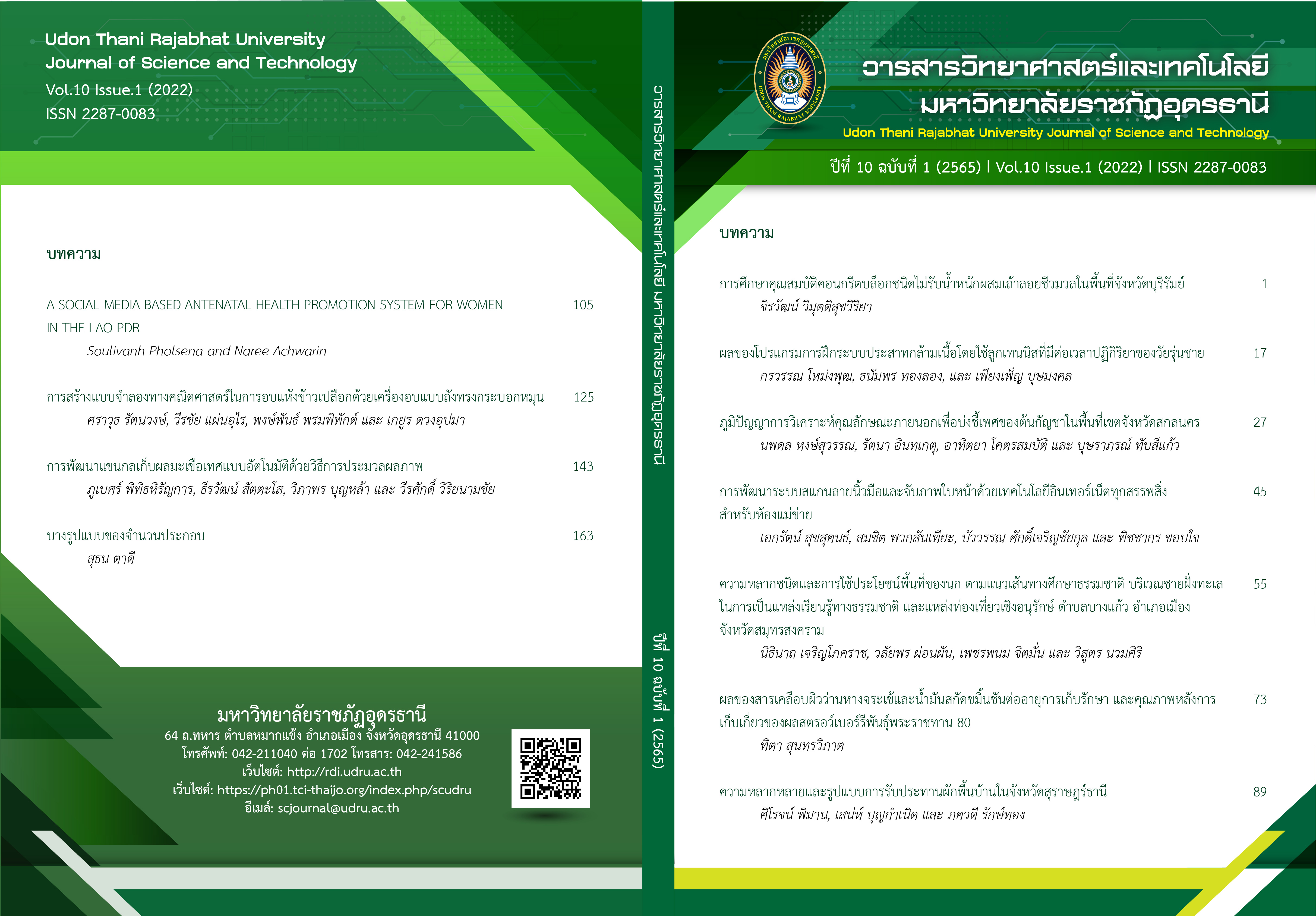ผลของสารเคลือบผิวว่านหางจระเข้และน้ำมันสกัดขมิ้นชันต่ออายุการเก็บรักษาและคุณภาพหลังการเก็บเกี่ยวของผลสตรอว์เบอร์รีพันธุ์พระราชทาน 80
Main Article Content
บทคัดย่อ
การศึกษาผลของสารเคลือบผิวว่านหางจระเข้และน้ำมันสกัดขมิ้นชันต่ออายุการเก็บรักษาและคุณภาพหลังการเก็บเกี่ยวของผลสตรอว์เบอร์รีพันธุ์พระราชทาน 80 เมื่อเก็บรักษาที่อุณหภูมิห้อง (26±2) ºC ความชื้นสัมพันธ์ 60-75% จากการทดลองพบว่าสารเคลือบผิวว่านหางจระเข้ความเข้มข้น 75% ร่วมกับน้ำมันสกัดขมิ้นชันสามารถชะลออัตราการหายใจ ลดการสูญเสียน้ำหนัก และการสุกของผลสตรอว์เบอร์รีได้ดีกว่าผลสตรอว์เบอร์รีที่เคลือบผิวด้วยว่านหางจระเข้และน้ำมันสกัดขมิ้นชันที่ความเข้มข้น 50%, 100% และไม่ได้เคลือบผิว (P<0.05) ตามลำดับ สำหรับการตรวจสอบการเปลี่ยนแปลงทางกายภาพ และการเปลี่ยนแปลงทางเคมีผลสตรอว์เบอร์รีทุกวัน พบว่าสารเคลือบผิวว่านหางจระเข้ผสมน้ำมันสกัดขมิ้นชันที่ทุกระดับความเข้มข้นนอกจากจะช่วยเพิ่มความมันวาวให้ผิวผลแล้วยังสามารถลดอัตราการเกิดบาดแผลที่เกิดจากการขัดสีที่ผิวของผลได้ นอกจากนี้ยังสามารถลดอัตราการสูญเสียน้ำหนัก ลดการเปลี่ยนแปลงสีของผลสตรอว์เบอร์รี การเปลี่ยนแปลงลักษณะเนื้อสัมผัส
และปริมาณวิตามินซีได้ (P<0.05)
ดังนั้นการใช้สารเคลือบผิวธรรมชาติเคลือบผลสตรอว์เบอร์รีนี้อาจจะเป็นอีกแนวทางหนึ่งที่ช่วยการยืดอายุการเก็บรักษาและยืดอายุการวางจำหน่ายผลผลิตแก่เกษตรกร ทั้งนี้เพื่อให้เกษตรกรสามารถผลิตสินค้าทางการเกษตรที่ปลอดภัยต่อผู้ผลิต ผู้บริโภค ตลอดจนเป็นมิตรต่อสิ่งแวดล้อม โดยยึดหลักการที่เกษตรกรสามารถเข้าถึงผลิตภัณฑ์ได้ภายในท้องถิ่น
Article Details
เอกสารอ้างอิง
คงกฤช อินทแสน. (ม.ป.ป.). สตรอเบอรี่. ศูนย์ส่งเสริมการเกษตรที่สูง จังหวัดกาญจนบุรี. สืบค้นเมื่อวันที่ 21 กันยายน 2564, จาก https://esc.doae.go.th/wp-content/ uploads/2015/02/stawberry.pdf
ดนัย บุณยเกียรติ. (2540). สรีรวิทยาหลังการเก็บเกี่ยวพืชสวน. เชียงใหม่: คณะเกษตรศาสตร์ มหาวิทยาลัยเชียงใหม่.
ดนัย บุณยเกียรติ และ นิธิยา รัตนาปนนท์. (2535). การปฏิบัติการหลังการเก็บเกี่ยวผักและ ผลไม้. กรุงเทพฯ: สำนักพิมพ์โอเดียนสโตร์.
ธเนศวร์ สีระแก้ว, ชญาน์นันท์ โค้วอินทร์, นิสิต บุญเพ็ง และ จงรัก อิ่มใจ. (2556). เกษตรกร GAP ดีเด่น สาขาระบบการจัดการคุณภาพ GAP: พืช. วิจัยและพัฒนาการเกษตร สำนักวิจัยและพัฒนาการเกษตร เขตที่ 1 (สวพ.1), 14(1), 3-7.
Amarante, C., & Bank, N. H. (2001). Postharvest physiology and quality of coated fruits and vegetables. Horticultural Reviews, 26, 161- 238.
AOAC. (1984). Methods of Analysis (14th ed.). Washington, DC: Association of Official Analytical Chemists.
Baldwin, E. A. (1994). Edible coating for fresh fruits and vegetables: past present, and future. In: Krochta, J. M., Baldwin, E. A., & Nisperos, M.O. Carriedo (Eds.), Edible coatings and films to improve food quality (pp. 25-64). Lancaster, Basel: Technomic Publishing Inc.
Baldwin, E. A., Nisperos, M. O., Hagenmaier, R. H., & Baker, R. A. (1997). Use of lipids in edible coatings for food products. Food Technology, 51, 56-62.
Bautista-Banos, S., Hernandez-Lauzardo, A.N., Velazquez-del Valle, M.G., Hernandez-Lopez, M., Barka, E. A., Bosquez-Molina, E., & Wilson, C. (2006). Chitosan as a potential natural compound to control pre and postharvest diseases of horticulture commodities. Crop Protection, 25, 108-118.
Chien, P. J., Sheu, F., & Lin, H. R. (2007). Coating citrus (Murcott tangor) fruit with low molecular weight chitosan increase postharvest quality and shelf life. Food Chemistry, 100, 1120-1164.
Hamid, H. (2014). Effect of Aloe vera gel coating on antioxidant capacity, antioxidant enzyme activities and decay in raspberry fruit. LWT- Food Science and Technology, 60(1), 495-501.
Hassanpour, H. (2015). Effect of Aloe vera gel coating on antioxidant capacity, antioxidant enzyme activities and decay in raspberry fruit. LWT-Food Science Technology, 83, 54-57.
Liu, H., Song, L., You, Y., Li, Y., Duan, X., Jiang, Y., & Lu, W. (2011). Cold storage duration affects litchi fruit quality, membrane permeability, enzyme activities and energy charge during shelf time at ambient temperature. Postharvest Biology Technology, 60, 24-30.
Mendy, T. K., Misran, A., Mahmud, T. M. M., & Ismail, S. I. (2019). Application of Aloe vera coating delays ripening and extend the shelf life of papaya fruit. Scientia Horticulturae, 246, 769-776.
Pornchan, J., Teerada, W., Pranee, R., & Kanogwan, S. (2016). Effect of molecular weights of chitosan coating on postharvest quality and physicochemical characteristics of mango fruit. Food Science and Technology, 73, 28-36.
Ranganna, S. (1997). Manual of Analysis of Fruit and Vegetables Products. New Delhi: Tats McGraw-Hill Publishing Company Limited. New Delhi. 634 p.
Rasouli, M., Saba, M. K., & Ramezanian, A. (2019). Inhibitory effect of salicylic acid and Aloe vera gel edible coating on microbial load and chilling injury of orange fruit. Scientia Horticulturae, 247, 27-34.
Rooney, M. (2000). Active and intelligent packaging of fruit and vegetables. In: B. P. F. Day. (ed). Proceedings of the International Conference of Fresh-cut Produce, September 9-10, 1999. Chipping Campden, Gloucestershire. 9-10.
Sánchez-Machado, D. I., López-Cervantes, J., Sendón, R., & Sanches-Silva, A. (2017). Aloe vera: ancient knowledge with new frontiers. Trends in Food Science & Technology, 61, 94-102.
Shagufta, N., Saiqa, I., Zahida, P., & Sumera, J. (2010). Chemical Analysis of Essential Oils from Turmeric (Curcuma longa) Rhizome Through GC-MS. Asian Journal of Chemistry, 22(4), 3153-3158.
Sirijariyawat, A., & Charoenrein, S. (2014). Texture and pectin content of four frozen fruits treated with calcium. Journal of Food Process, 38, 1346-1355.
Vieira, J. M., Flores-López, M. L., de RodrÍquez, D. J., Sousa, M. C., Vicente, A. A., & Martins, J. T. (2016). Effect of chitosan–Aloe vera coating on postharvest quality of blueberry (Vaccinium corymbosum) fruit. Postharvest Biology Technology, 116, 88-97.
Vincenzo, S., Monica R. L., Teresa, M. P., Angelo, M. G., & Marco, P. (2019). Evaluation of Aloe arborescens gel as new coating to maintain the organoleptic and functional properties of strawberry (Fragaria × ananassa cv. Cadonga) fruits. Food Science and Technology, 55(2), 1-10


